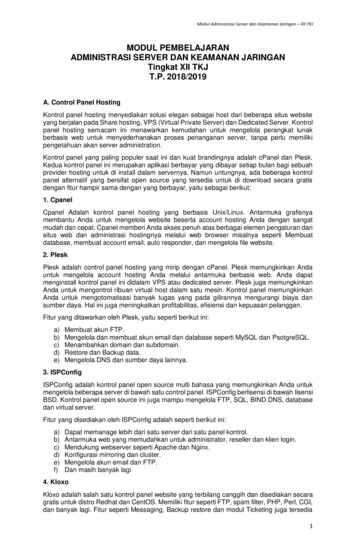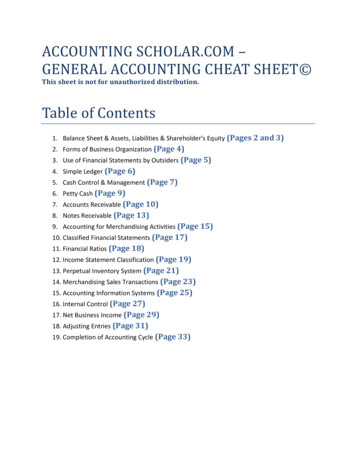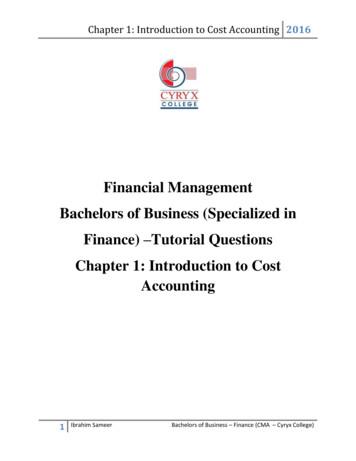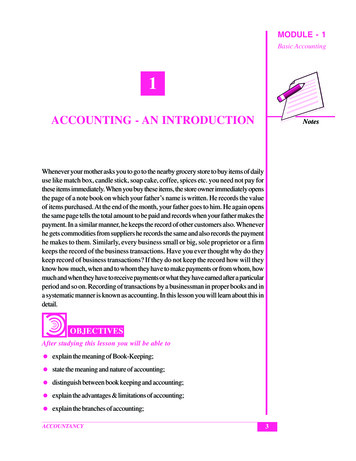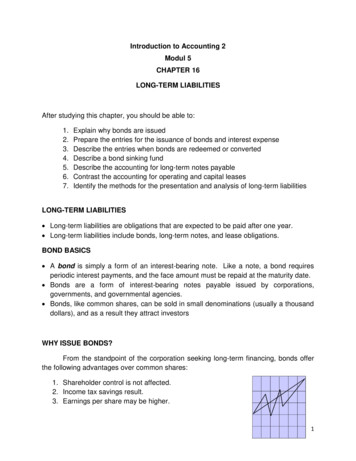
Transcription
Introduction to Accounting 2Modul 5CHAPTER 16LONG-TERM LIABILITIESAfter studying this chapter, you should be able to:1.2.3.4.5.6.7.Explain why bonds are issuedPrepare the entries for the issuance of bonds and interest expenseDescribe the entries when bonds are redeemed or convertedDescribe a bond sinking fundDescribe the accounting for long-term notes payableContrast the accounting for operating and capital leasesIdentify the methods for the presentation and analysis of long-term liabilitiesLONG-TERM LIABILITIES Long-term liabilities are obligations that are expected to be paid after one year. Long-term liabilities include bonds, long-term notes, and lease obligations.BOND BASICS A bond is simply a form of an interest-bearing note. Like a note, a bond requiresperiodic interest payments, and the face amount must be repaid at the maturity date. Bonds are a form of interest-bearing notes payable issued by corporations,governments, and governmental agencies. Bonds, like common shares, can be sold in small denominations (usually a thousanddollars), and as a result they attract investorsWHY ISSUE BONDS?From the standpoint of the corporation seeking long-term financing, bonds offerthe following advantages over common shares:1. Shareholder control is not affected.2. Income tax savings result.3. Earnings per share may be higher.1
DISADVANTAGES The major disadvantages resulting from the use of bonds are thato Interest must be paid on a periodic basis, ando Principal (face value) of the bonds must be paid at maturity.TYPES OF BONDS SECURED AND UNSECURED Secured bonds have specific assets of the issuer pledged as collateral for thebonds. A bond can be secured by real estate or other assets. Unsecured bonds are issued against the general credit of the borrower; they are alsocalled debenture bonds.TYPES OF BONDS TERM AND SERIAL BONDSBonds that mature at a single specified future date are called term bonds.In contrast, bonds that mature in installments are called serial bonds.TYPES OF BONDS REGISTERED AND BEARER Registered bonds are issued in the name of the owner and have interest paymentsmade by cheque to bondholders of record.Bearer or coupon bonds are not registered; thus bondholders must send in couponsto receive interest payments.TYPES OF BONDS CONVERTIBLE, REDEEMABLE, AND RETRACTABLE2
Convertible bonds permit bondholders to convert the bonds into common sharesat their option.Redeemable (callable) bonds are subject to call and retirement at a stated dollaramount prior to maturity at the option of the issuer.Retractable bonds are subject to redemption prior to maturity at the option of theholder.ISSUING PROCEDURES The face value is the amount of principal due at the maturity date.The contractual interest rate, often referred to as the stated rate, is the rate usedto determine the amount of cash interest the borrower pays and the investorreceives.Bond certificates, which provide information such as name of issuer, face value,contractual interest rate and maturity date, are authorized by the Board andprinted.DETERMINING THE MARKET VALUE OF BONDSThe market value (present value) of a bond is a function of three factors:o The dollar amounts to be received,o The length of time (n) until the amounts are received, ando The market rate of interest (i) which is the rate investors demand forloaning funds to the corporation.The market or effective rate of interest is determined by transactions between buyersand sellers of similar bonds. The market rate of interest is affected by a variety offactors, including:1. investors assessment of current economic conditions, and2. future expectations.The time value of money concept recognizes that an amount of cash to be receivedtoday is worth more than the same amount of cash to be received in the future. The process of finding the present value is referred to as discounting the futureamounts.3
The time value of money concept recognizes that an amount of cash to bereceived today is worth more than the same amount of cash to be received in thefuture.TIME DIAGRAM DEPICTING CASH FLOWSILLUSTRATION 16-6 CALCULATING THE PRESENT VALUE OF BONDSThe market value of a bond is equal to the present value of all the future cashpayments promised by the bond.Present value of 100,000 received in 10 periods 100,000 x 0.82035 (Table B-1: n 10, i 2%)Present value of 2,000 received annually for 10 periods 2,000 x 8.98259 (Table B-2: n 10, i 2%)Present (market) value of bonds 82,03517,965 100,000ACCOUNTING FOR BOND ISSUESBonds may be issued at: Face valueBelow face value (discount) orAbove face value (premium).ISSUING BONDS AT FACE VALUEBonds payable are reported in the long-term liability section of the balance sheetbecause the maturity date (January 1, 2008 in this case) is more than one year away.4
Assuming that interest is payable semi-annually on January 1 and July 1 on thebonds, interest of 25,000 ( 1,000,000 x 5% x 6/12) must be paid on July 1, 2003. Theentry for the payment is:DISCOUNT OR PREMIUM ON BONDS Bonds may be issued below or above face value.If the market (effective) rate of interest is higher than the contractual (coupon)rate, the bonds will sell at less than face value, or at a discount.If the market rate of interest is less than the contractual rate on the bonds, thebonds will sell above face value, or at a premium.ILLUSTRATION 16-7 INTEREST RATES AND BOND PRICESISSUING BONDS AT A DISCOUNTAssume that on January 1, 2003, Candlestick Inc. sells 1 million, 5-year, 5percent bonds at 95.7345 (95.7345 percent of face value) with interest payable on July1 and January 1. The entry to record the issue is:5
STATEMENT PRESENTATION OF BOND DISCOUNTThe Discount on Bonds Payable account has a debit balance and is deductedfrom Bonds Payable on the balance sheet, as illustrated below:Long-term liabilitiesBonds payableLess: Discount on bonds payable 1,000,00042,655 957,345The 957,345 represents the carrying (or book) value of the bonds. On the dateof issue, this amount equals the market price of the bonds.STRAIGHT-LINE METHOD OF BOND DISCOUNT AMORTIZATION To comply with the matching principle, it follows that bond discount should beallocated systematically to each accounting period benefiting from the use of thecash proceeds.The straight-line method of amortization of bond discount allocates the sameamount to interest expense each interest period.FORMULA FOR STRAIGHT-LINE METHOD OF BOND DISCOUNT AMORTIZATIONBond Discount Amortization EntriesThe entry to record the payment of bond interest and the amortization of bonddiscount on the first interest date (July 1, 2003) is:6
Over the term of the bonds, the balance in Discount on Bonds Payable willdecrease annually by the same amount until it reaches zero at the maturity date of thebonds. Thus, the carrying value of the bonds at maturity will be equal to the face valueof the bonds.EFFECTIVE INTEREST METHOD OF AMORTIZATION The effective interest method is an alternative to the straight-line method ofamortization.Bond interest expense is calculated by multiplying the carrying value of the bonds atthe beginning of the period by the effective interest rate.The credit to Cash (or Bond Interest Payable) is calculated by multiplying the facevalue of the bonds by the contractual interest rate.The bond discount or premium amortization amount is then determined bycomparing bond interest expense with the interest paid or accrued.BOND DISCOUNT AMORTIZATION ENTRIESThe entry to record the payment of bond interest and the amortization of bonddiscount on the first interest date (July 1, 2003) is:Over the term of the bonds, the balance in Discount on Bonds Payable willdecrease annually by the same amount until it reaches zero at the maturity date of thebonds. Thus, the carrying value of the bonds at maturity will be equal to the face valueof the bonds.ISSUING BONDS AT A PREMIUMTo illustrate issuing bonds at a premium, assume that on January 1, 2003,Candlestick Inc. sells 1 million, 5-year, 5 percent bonds at 104.4915 (104.4915 percent7
of face value) with interest payable on July 1 and January 1. The entry to record theissue is:STATEMENT PRESENTATION OF BONDS PREMIUMPremium on Bonds Payable has a credit balance and therefore is added toBonds Payable on the balance sheet, as illustrated below:Long-term liabilitiesBonds payable 100,000Add: Premium on bonds payable 44,915 1,044,915The 1,044,915 represents the carrying (or book) value of the bonds. On thedate of issue, this amount equals the market price of the bonds.BOND PREMIUM AMORTIZATION ENTRIESThe entry to record the payment of bond interest and the amortization of bondpremium using the straight-line method on the first interest date (July 1, 2003) is:Over the term of the bonds, the balance in Premium on Bonds Payable willdecrease annually by the same amount until it reaches zero at the maturity date of thebonds. Thus, the carrying value of the bonds at maturity will be equal to the face valueof the bonds.EFFECTIVE INTEREST METHOD OF AMORTIZATION8
BOND PREMIUM AMORTIZATION ENTRIESThe entry to record the payment of bond interest and the amortization of bondpremium on the first interest date (July 1, 2003) using the effective interest method is:Over the term of the bonds, the balance in Premium on Bonds Payable willdecrease annually by the same amount until it reaches zero at the maturity date of thebonds. Thus, the carrying value of the bonds at maturity will be equal to the face valueof the bonds.ISSUING BONDS BETWEEN INTEREST DATESWhen bonds are issued between interest payment dates, the investor must paythe market price for the bonds plus accrued interest since the last interest date.Assume that on March 1 Candlestick Inc. sells 1,000,000 of 5-year, 5 percentbonds at face value plus accrued interest. Interest is payable semi-annually on July 1and January 1. The accrued interest is 8,333 ( 1,000,000 x 5% x 2/12). The totalproceeds on the sale of bonds is 1,008,333. The entry to record the sale is:9
At the first interest date, it is necessary to eliminate the bond interest payablebalance and to recognize the bond interest expense for the four months (March 1 toJuly 1) that the bonds have been outstanding.Interest expense in this example is 16,667 ( 1,000,000 x 5% x 4/12). The entryon July 1 to record the first interest payment is:REDEEMING BONDS AT MATURITYRegardless of the issue price of bonds, the book value of the bonds at maturity willequal their face value. Assuming that the interest for the last interest period is paid andrecorded separately, the entry to record the redemption of the Candlestick bonds atmaturity is:BOND RETIREMENTS Bonds may be redeemed before maturity because a company may decide to reduceinterest cost and remove debt from its balance sheet. When bonds are retired before maturity it is necessary too Eliminate the carrying value of the bonds at the redemption date after updatinginterest,o Record the cash paid, ando Recognize the gain or loss on redemption and report as other gains or otherlosses in the income statement.ACCOUNTING FOR OTHER LONG-TERM LIABILITIES Long-term notes payable are similar to short-term interest-bearing notes payableexcept that the term of the note exceeds one year.A long-term note may be secured by a mortgage that pledges title to specific assetsas security for a loan.Mortgage notes payable are widely used in the purchase of homes by individualsand in the acquisition of capital assets by many small and some large companies.10
Balance Sheet Presentation of Bond Investments Such securities are classified as long-term investments under the captionInvestments.These investments are reported at their cost less any amortized premium or plusany amortized discount.The market (fair) value of the bond investment should be disclosed, either on theface of the balance sheet or in an accompanying note.MORTGAGE NOTES PAAYBLE Mortgage notes payable are recorded initially at face value and entries are requiredsubsequently for each instalment payment.o Fixed principal paymento Blended principal and interestIn the balance sheet, the reduction in principal for the next year is reported as acurrent liability, and the remaining unpaid principal balance is classified as a longterm liability.ILLUSTRATION 16-21 INSTALMENT PAYMENT SCHEDULE FIXED PRINCIPALPAYMENTTo illustrate, assume that Belanger Ltd. issues a 120,000, 7 percent, 5-yearnote on January 1, 2003, to obtain needed financing for the construction of a newresearch laboratory. The terms provide for monthly instalment payments of 2,000( 120,000/60). The instalment payment schedule for the first few months is shownbelow:ILLUSTRATION 16-22 INSTALMENT PAYMENT SCHEDULE BLENDED PAYMENTTo illustrate, assume that Belanger Ltd. issues a 120,000, 7 percent, 5-yearnote on January 1, 2003, to obtain needed financing for the construction of a newresearch laboratory. The terms provide for monthly instalment payments of 2,376. Theinstalment payment schedule for the first few months is shown below:11
LEASE LIABILITIES OPERATING LEASE In an operating lease the intent is temporary use of the property by the lessee withcontinued ownership of the property by the lessor.The lease (rental) payments are recorded as an expense by the lessee and asrevenue by the lessor.LEASE LIABILITIES CAPITAL LEASES A capital lease transfers substantially all the benefits and risks of ownership fromthe lessor to the lessee.In a capital lease, the present value of the cash payments for the lease arecapitalized and recorded as an asset.LEASE LIABILITIES CAPITAL LEASES The lessee must record the lease as an asset (a capital lease) if any one of thefollowing conditions exist:o The lease transfers ownership of the property to the lessee (e.g., contains abargain purchase option).o The lease term is equal to 75% or more of the economic life of the leasedproperty.o The present value of the lease payments equals or ex
Redeemable (callable) bonds are subject to call and retirement at a stated dollar amount prior to maturity at the option of the issuer. . Bonds Payable on the balance sheet, as illustrated below: Long-term liabilities Bonds payable 100,000 Add: Premium on bonds payable 44,915 1,044,915 The 1,044,915 represents the carrying (or book) value of the bonds. On the date of issue, this amount .

